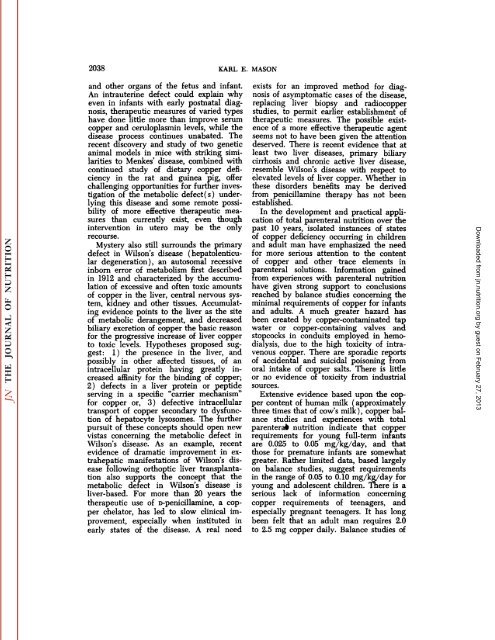conspectus of researchon copper metabolism and requirements
conspectus of researchon copper metabolism and requirements
conspectus of researchon copper metabolism and requirements
You also want an ePaper? Increase the reach of your titles
YUMPU automatically turns print PDFs into web optimized ePapers that Google loves.
2038 KARL E. MASON<br />
<strong>and</strong> other organs <strong>of</strong> the fetus <strong>and</strong> infant.<br />
An intrauterine defect could explain why<br />
even in infants with early postnatal diag<br />
nosis, therapeutic measures <strong>of</strong> varied types<br />
have done little more than improve serum<br />
<strong>copper</strong> <strong>and</strong> ceruloplasmin levels, while the<br />
disease process continues unabated. The<br />
recent discovery <strong>and</strong> study <strong>of</strong> two genetic<br />
animal models in mice with striking simi<br />
larities to Menkes' disease, combined with<br />
continued study <strong>of</strong> dietary <strong>copper</strong> defi<br />
ciency in the rat <strong>and</strong> guinea pig, <strong>of</strong>fer<br />
challenging opportunities for further inves<br />
tigation <strong>of</strong> the metabolic defect(s) under<br />
lying this disease <strong>and</strong> some remote possi<br />
bility <strong>of</strong> more effective therapeutic mea<br />
sures than currently exist, even though<br />
intervention in utero may be the only<br />
recourse.<br />
Mystery also still surrounds the primary<br />
defect in Wilson's disease (hepatolenticu-<br />
lar degeneration), an autosomal recessive<br />
inborn error <strong>of</strong> <strong>metabolism</strong> first described<br />
in 1912 <strong>and</strong> characterized by the accumu<br />
lation <strong>of</strong> excessive <strong>and</strong> <strong>of</strong>ten toxic amounts<br />
<strong>of</strong> <strong>copper</strong> in the liver, central nervous sys<br />
tem, kidney <strong>and</strong> other tissues. Accumulat<br />
ing evidence points to the liver as the site<br />
<strong>of</strong> metabolic derangement, <strong>and</strong> decreased<br />
biliary excretion <strong>of</strong> <strong>copper</strong> the basic reason<br />
for the progressive increase <strong>of</strong> liver <strong>copper</strong><br />
to toxic levels. Hypotheses proposed sug<br />
gest: 1) the presence in the liver, <strong>and</strong><br />
possibly in other affected tissues, <strong>of</strong> an<br />
intracellular protein having greatly in<br />
creased affinity for the binding <strong>of</strong> <strong>copper</strong>;<br />
2) defects in a liver protein or peptide<br />
serving in a specific "carrier mechanism"<br />
for <strong>copper</strong> or, 3) defective intracellular<br />
transport <strong>of</strong> <strong>copper</strong> secondary to dysfunc<br />
tion <strong>of</strong> hepatocyte lysosomes. The further<br />
pursuit <strong>of</strong> these concepts should open new<br />
vistas concerning the metabolic defect in<br />
Wilson's disease. As an example, recent<br />
evidence <strong>of</strong> dramatic improvement in extrahepatic<br />
manifestations <strong>of</strong> Wilson's dis<br />
ease following orthoptic liver transplanta<br />
tion also supports the concept that the<br />
metabolic defect in Wilson's disease is<br />
liver-based. For more than 20 years the<br />
therapeutic use <strong>of</strong> D-penicillamine, a cop<br />
per chelator, has led to slow clinical im<br />
provement, especially when instituted in<br />
early states <strong>of</strong> the disease. A real need<br />
exists for an improved method for diag<br />
nosis <strong>of</strong> asymptomatic cases <strong>of</strong> the disease,<br />
replacing liver biopsy <strong>and</strong> radio<strong>copper</strong><br />
studies, to permit earlier establishment <strong>of</strong><br />
therapeutic measures. The possible exist<br />
ence <strong>of</strong> a more effective therapeutic agent<br />
seems not to have been given the attention<br />
deserved. There is recent evidence that at<br />
least two liver diseases, primary biliary<br />
cirrhosis <strong>and</strong> chronic active liver disease,<br />
resemble Wilson's disease with respect to<br />
elevated levels <strong>of</strong> liver <strong>copper</strong>. Whether in<br />
these disorders benefits may be derived<br />
from penicillamine therapy has not been<br />
established.<br />
In the development <strong>and</strong> practical appli<br />
cation <strong>of</strong> total parenteral nutrition over the<br />
past 10 years, isolated instances <strong>of</strong> states<br />
<strong>of</strong> <strong>copper</strong> deficiency occurring in children<br />
<strong>and</strong> adult man have emphasized the need<br />
for more serious attention to the content<br />
<strong>of</strong> <strong>copper</strong> <strong>and</strong> other trace elements in<br />
parenteral solutions. Information gained<br />
from experiences with parenteral nutrition<br />
have given strong support to conclusions<br />
reached by balance studies concerning the<br />
minimal <strong>requirements</strong> <strong>of</strong> <strong>copper</strong> for infants<br />
<strong>and</strong> adults. A much greater hazard has<br />
been created by <strong>copper</strong>-contaminated tap<br />
water or <strong>copper</strong>-containing valves <strong>and</strong><br />
stopcocks in conduits employed in hemodialysis,<br />
due to the high toxicity <strong>of</strong> intra<br />
venous <strong>copper</strong>. There are sporadic reports<br />
<strong>of</strong> accidental <strong>and</strong> suicidal poisoning from<br />
oral intake <strong>of</strong> <strong>copper</strong> salts. There is little<br />
or no evidence <strong>of</strong> toxicity from industrial<br />
sources.<br />
Extensive evidence based upon the cop<br />
per content <strong>of</strong> human milk (approximately<br />
three times that <strong>of</strong> cow's milk ), <strong>copper</strong> bal<br />
ance studies <strong>and</strong> experiences with total<br />
parenteral nutrition indicate that <strong>copper</strong><br />
<strong>requirements</strong> for young full-term infants<br />
are 0.025 to 0.05 mg/kg/day, <strong>and</strong> that<br />
those for premature infants are somewhat<br />
greater. Rather limited data, based largely<br />
on balance studies, suggest <strong>requirements</strong><br />
in the range <strong>of</strong> 0.05 to 0.10 mg/kg/day for<br />
young <strong>and</strong> adolescent children. There is a<br />
serious lack <strong>of</strong> information concerning<br />
<strong>copper</strong> <strong>requirements</strong> <strong>of</strong> teenagers, <strong>and</strong><br />
especially pregnant teenagers. It has long<br />
been felt that an adult man requires 2.0<br />
to 2.5 mg <strong>copper</strong> daily. Balance studies <strong>of</strong><br />
Downloaded from<br />
jn.nutrition.org<br />
by guest on February 27, 2013
















